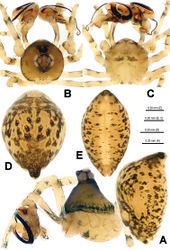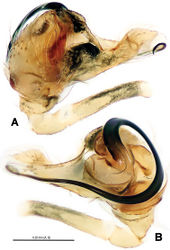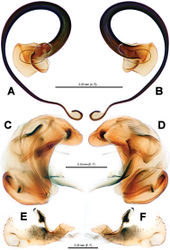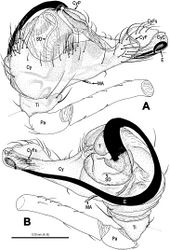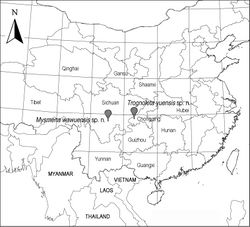Trogloneta yuensis
| Notice: | This page is derived from the original publication listed below, whose author(s) should always be credited. Further contributors may edit and improve the content of this page and, consequently, need to be credited as well (see page history). Any assessment of factual correctness requires a careful review of the original article as well as of subsequent contributions.
If you are uncertain whether your planned contribution is correct or not, we suggest that you use the associated discussion page instead of editing the page directly. This page should be cited as follows (rationale):
Citation formats to copy and paste
BibTeX: @article{Lin2013ZooKeys303, RIS/ Endnote: TY - JOUR Wikipedia/ Citizendium: <ref name="Lin2013ZooKeys303">{{Citation See also the citation download page at the journal. |
Ordo: Araneae
Familia: Mysmenidae
Genus: Trogloneta
Name
Trogloneta yuensis Lin & Li, 2013 sp. n. – Wikispecies link – ZooBank link – Pensoft Profile
Material examined
Holotype: CHINA, Chongqing: Beibei District, Jinyun Mt., Guankou, 29°50.261'N, 106°23.811'E, elevation ca 531 m, 5 April 2010, by sieving, Zhisheng Zhang leg., male (SCUM).
Etymology
The specific name is taken from the type locality; adjective. Yu is short name for Chongqing.
Diagnosis
This new species has the following combinations of typical generic features: AME dark, smaller ALE (Fig. 8B); eyes at the apex (Fig. 8A); male leg I with a femoral spot and a metatarsal clasping spine; highly elevated and conical carapace (Fig. 8A); male pedipalp large (Fig. 8B–C). All indicating that this species belongs to the genus Trogloneta. This new species is similar to Trogloneta denticocleari Lin & Li, 2008 (see Lin and Li 2008[1]: 513, figs 16A–E, 17A–C) in habitus (Fig. 8A), eyes arrangement (Fig. 8B), pedipalp shape (Figs 9A–B, 11A–B), cymbial configuration (Figs 11A, 12E) and a trichobothrium present at pedipalpal tibia (Fig. 11A–B), but distinguished from the latter by a long, distally hooked embolus attaching accessory membrane (Figs 10A–B, 12A–B), a long fingerlike median apophysis (Figs 10C–D, 12C–D), a laminar cymbial conductor (Fig. 12E), a distally aquiline, basally constricted cymbial process (Figs 10E–F, 11A, 12E) and a dorsal-posterior opisthosomal tubercle (Fig. 8A, D–E).
Description
Male (holotype). Somatic characters see Fig. 8A–E. Coloration: Prosoma yellow centrally, dark marginally. Clypeus black. Sternum yellow, with a pair of shoulder dark speckles. Opisthosoma yellow, with irregular dark spots.
Measurement: Total length 1.01. Prosoma 0.45 long, 0.45 wide, 0.59 high. Opisthosoma 0.54 long, 0.55 wide, 0.95 high. Clypeus 0.32 high. Sternum 0.31 long, 0.29 wide. Length of legs [total length (femur + patella + tibia + metatarsus + tarsus)]: I 1.42 (0.43, 0.17, 0.32, 0.29, 0.21); II 1.15 (0.38, 0.16, 0.23, 0.22, 0.16); III 0.96 (0.29, 0.13, 0.20, 0.18, 0.16); IV 1.15 (0.36, 0.14, 0.26, 0.22, 0.17).
Prosoma (Fig. 8A–C): Carapace near round. Cephalic pars sharply elevated, slope forward and backward. Ocular area at apex. Eight eyes in two rows. AME black, others white. AME smallest, ALE largest. ALE>PLE>PME>AME. ALE, PME and PLE contiguous. ARE procurved, PRE strongly procurved. Chelicerae pale, small, shorter than endites (Fig. 8A), fang furrow with 2 promaiginal and 1 retromarginal teeth.
Legs: Femora and other segments pale yellow mesially, but grey proximally and distally. Leg formula: I-II-IV-III. Leg I with a subdistal sclerotized femoral spot ventrally and a submesial metatarsal clasping macroseta prolaterally. Patellae I–IV with a dorsal seta distally. Tibiae I–IV with a dorsal seta proximally. Tibiae I, II and IV with 3 trichobothria, but 4 on tibia III. Metatarsi I–IV lack trichobothrium.
Opisthosoma (Fig. 8A, D–E): elliptic dorsally, fusiform posteriorly, triangular laterally, with a tubercle at rear. Spinnerets grey, the anteriors larger than the posteriors. Colulus small, tongue-shaped. Anal tubercle pale.
Pedipalp (Figs 9–12): Large, strongly sclerotized. Femur as 2.5 times long as patella (Fig. 9A, B). Patella short, with a few setae. Tibia wider than long, nearly cup-shaped, covered with a dorsal trichobothrium and a few marginal long setae ventrally (Figs 11A–B). Cymbium large (Figs 10E–F, 12E), membranous, paracymbium flattened, covered with dense long setae. A long cymbial process (aquiline distally, constricted proximally) arisen from inner side subdistal margin (Fig. 12E). Cymbial fold distinctly, with long setae. Distal primary cymbial conductor membranous, translucent, attaching with a cluster of setae (Fig. 12E). Tegulum smooth, sclerotized (Fig. 10C–D). Spermatic duct long, visible through subtegulum (Fig. 11C–D). A long, fingerlike median apophysis starts at the junction between tegulum and subtegulum (Figs 10D, 11D). Embolus long, arched, strongly sclerotized, gradually diminishing from base to end (Figs 9B, 12A–B). Embolic end unciform, with accessory membrane (Fig. 12A–B), hidden behind cymbial conductor (Figs 9B, 11B).
Female. Unknown.
Distribution
Known only from the type locality (Fig. 13).
Original Description
- Lin, Y; Li, S; 2013: Two new species of the genera Mysmena and Trogloneta (Mysmenidae, Araneae) from Southwestern China ZooKeys, 303: 33-51. doi
Other References
- ↑ Lin Y, Li S (2008) Mysmenid spiders of China (Araneae: Mysmenidae). Annales Zoologici 58 (3): 487-520. doi: 10.3161/000345408X364337
Images
|
